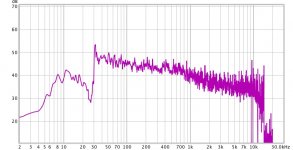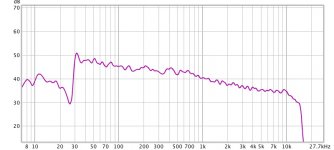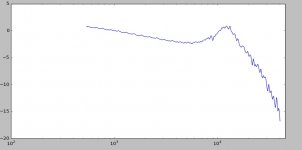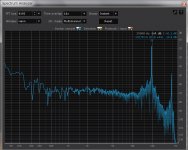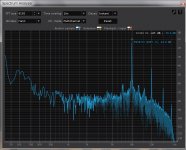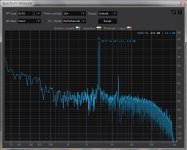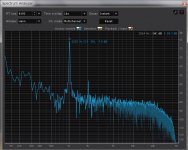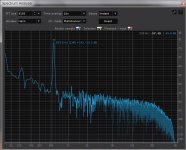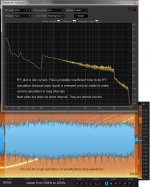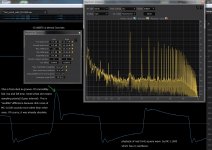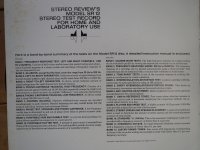Here is an RTA (real-time frequency analysis) of a sine glide tone, 20k-30 Hz, recorded by Radio Shack; taken from the RS test record I bought around 1958, just guessing.
After being used many times for 35 years, burned to a CD (probably Decca MC cartridge and my Leach DIY pre-pre-amp), then the CD to an Apple lossless file.... then out an analog headphone jack (don't ask why) to a $4 DCA and back into REW by USB. Certainly more than two dozen conversions and devices between the General Radio variable oscillator RS used (which may not have been too precise) and the plot below.
The first plot is raw and the second is with 1/12 smoothing that I generally use.
All things considered, the plot of this ancient vinyl recording seems astonishing to me.
B.
After being used many times for 35 years, burned to a CD (probably Decca MC cartridge and my Leach DIY pre-pre-amp), then the CD to an Apple lossless file.... then out an analog headphone jack (don't ask why) to a $4 DCA and back into REW by USB. Certainly more than two dozen conversions and devices between the General Radio variable oscillator RS used (which may not have been too precise) and the plot below.
The first plot is raw and the second is with 1/12 smoothing that I generally use.
All things considered, the plot of this ancient vinyl recording seems astonishing to me.
B.
Attachments
Last edited:
Here is an RTA (real-time frequency analysis) of a sine glide tone, 20k-30 Hz, recorded by Radio Shack; taken from the RS test record I bought around 1958, just guessing.
Mixing RTA, FFT, and swept tones allows for lots places for error. There are signal processing techniques to make an almost totally clean plot from a typical test LP sweep.
Yes, exactly as I've presented it.Mixing RTA, FFT, and swept tones allows for lots places for error. There are signal processing techniques to make an almost totally clean plot from a typical test LP sweep.
1. the initial recording must have been wonderfully orderly and we are talking mid-50's.
2. the mountain of "impediments"* between the audio oscillator and the post is monumental; yet here we are looking a a pretty orderly plot, and
3. it would be a simple matter to tweak that orderly plot or to do better recording 60 yrs later.
B.
*I bet some well informed folks out there know something of the history and dates of RIAA recording equalization
Yes, exactly as I've presented it.
Not what I meant, the FFT of a swept sine does not make sense. From the sudden jump at 30Hz or so (which no physical cartridge can do) and the slope this is some kind of averaged FFT of a sweep which needs more data to be useful. Once you recorded the file the subsequent transfers (especially the digital ones) have no reason to change anything.
CBS Labs had sweeps on test LP's in 1963. The constant velocity 500 to 50k one is useful since an unequalized cartridge should be flat (no error from RIAA).
Attachments
Last edited:
Can't say as I have any idea what point you are trying to make. Perhaps you could simply state what point you are making?
Doing an RTA/FFT in REW seems to work just fine with random noise, music recordings (esp organs where you can actually count the pipes), and swept sine sweeps from generators. And always has.
My point, once again, is that the results look awfully good to me and make vinyl from mid-50's seem not so antique, DESPITE the signal examined here having passed through a mountain of threats both analog and digital.
That, and the slight elaborations of that point in my previous post, and that I am only presenting one little data plot for others to note, is all I mean to convey. I have "no dog in the fight", whatever it is you may be arguing about.
B.
Doing an RTA/FFT in REW seems to work just fine with random noise, music recordings (esp organs where you can actually count the pipes), and swept sine sweeps from generators. And always has.
My point, once again, is that the results look awfully good to me and make vinyl from mid-50's seem not so antique, DESPITE the signal examined here having passed through a mountain of threats both analog and digital.
That, and the slight elaborations of that point in my previous post, and that I am only presenting one little data plot for others to note, is all I mean to convey. I have "no dog in the fight", whatever it is you may be arguing about.
B.
Last edited:
Got it. Thanks. But I thought I was doing a swell job in posting some incidental data collection that took me little time but might be of interest to some, even if imperfect.You're not doing a very good signal analysis, that's what Scott is saying.
It may take me a while to get inspired to cut the glide tone segment from the Apple lossless file and then figure out how to post it. But I'm glad to send the whole file to anybody with the urge who PMs.
B.
Perhaps you could simply state what point you are making?
I apologize if I was not clear, your plot shows 20dB roll off from 20Hz to 20kHz is that the response of your setup? If not there is no explanation. I assume one would want to demonstrate the actual cartridge + RIAA flatness.
I hesitate to get into the issues of FFT's and signals that are not time invariant, I doubt it would help.
Last edited:
My FFT plot
I also have a frequency response of my vinyl playback(MC-L1000) by test record in 60'. Mine is a swept signal from 500Hz to 20kHz. FFT plot shows a similar roll off like bentoronto. I would say this is because of a swept signal which is not preferable in long interval FFT. If you do FFT in a short interval, which means almost constant frequency is guaranteed, you can have the correct data. From the second plot to the sixth one is 8192 length by 96k sampling. The interval is nearly 84 m seconds (8192/96000). They are correct. The first plot is 38 second. This probably causes roll off.
I also have a frequency response of my vinyl playback(MC-L1000) by test record in 60'. Mine is a swept signal from 500Hz to 20kHz. FFT plot shows a similar roll off like bentoronto. I would say this is because of a swept signal which is not preferable in long interval FFT. If you do FFT in a short interval, which means almost constant frequency is guaranteed, you can have the correct data. From the second plot to the sixth one is 8192 length by 96k sampling. The interval is nearly 84 m seconds (8192/96000). They are correct. The first plot is 38 second. This probably causes roll off.
Attachments
All I am saying, again, is the plot is remarkably orderly, at least 35-10kHz. "Orderly" is foundational in working with systems. The decline with freq is similar to a pink noise plot and likely is just a figment of the FFT. I'm sure the technically adept can parse that.20dB roll off from 20Hz to 20kHz ...
There also seems to be a big drop north 10kHz, A million possible causes of which limitations of vinyl recording in the 50's is one (and playback with a stereo MC cartridge in the 90's is another). In a blind test, betcha nobody could hear the loss on acoustic music.
While the vinyl recording came from the great old "Radio Shack of Boston" of yesteryear, it is a Popular Science Magazine production. Prolly mono, not sure.
I hope what I've posted is helpful even if requiring correction. Hope I can disappear from this forum now.
B.
Last edited:
Yes, the odd slope is FFT versus sweep. As said, the smoothness is remarkable, and un-"flat" (actually not-level) is expected.
Appended to xx3stksm's images is a "true picture". The envelope display over the duration of the sweep should be flat. It does indeed seem to be pretty flat. Disregard single peaks, they are dirt in groove or in vinyl. Discounting multiple peaks as either dust or display artifacts, I see +/-1dB 500Hz-19KHz, which is excellent for 1960(?).
Appended to xx3stksm's images is a "true picture". The envelope display over the duration of the sweep should be flat. It does indeed seem to be pretty flat. Disregard single peaks, they are dirt in groove or in vinyl. Discounting multiple peaks as either dust or display artifacts, I see +/-1dB 500Hz-19KHz, which is excellent for 1960(?).
Attachments
square wave
Hi, PRR. Thank you for a detailed explanation.
I have another pic for your reference. There is a square wave (1kHz) cut in the groove for evaluating high-frequency response. This can be one answer how high vinyl can playback. Vinyl is not absolute band limited system, unlike digital one. Band limitation perhaps depends on circumstance, cartridge, tonearm, etc. This is my own band limitation. Others have their own.
Soft roll off at high frequency usually does not have hard ringing like brick-wall filter used in a digital system. My plot also has such a response. The disadvantage of vinyl is distortion. Square wave in digital system hardly has even order distortion because square wave initially doesn't have even order harmonics. But in an analog system, mechanical system inevitably has even order harmonics. The second order harmonics is less than the fundamental by 26dB(almost 5% THD). Both systems have advantages and disadvantages. I would say that's the principle in physics.
Hi, PRR. Thank you for a detailed explanation.
I have another pic for your reference. There is a square wave (1kHz) cut in the groove for evaluating high-frequency response. This can be one answer how high vinyl can playback. Vinyl is not absolute band limited system, unlike digital one. Band limitation perhaps depends on circumstance, cartridge, tonearm, etc. This is my own band limitation. Others have their own.
Soft roll off at high frequency usually does not have hard ringing like brick-wall filter used in a digital system. My plot also has such a response. The disadvantage of vinyl is distortion. Square wave in digital system hardly has even order distortion because square wave initially doesn't have even order harmonics. But in an analog system, mechanical system inevitably has even order harmonics. The second order harmonics is less than the fundamental by 26dB(almost 5% THD). Both systems have advantages and disadvantages. I would say that's the principle in physics.
Attachments
Yes, the odd slope is FFT versus sweep. As said, the smoothness is remarkable, and un-"flat" (actually not-level) is expected.
There also a very regular pattern in the noise which could be off center eccentricity.
It would be neat if there were a little device you could set the stylus into and it would have two exciter coils that could move the stylus the way an LP does. A dual output generator would drive this and allow for frequency response measurements to be made on a cart-arm setup. Is there such a thing?
It would be neat if there were a little device you could set the stylus into and it would have two exciter coils that could move the stylus the way an LP does. A dual output generator would drive this and allow for frequency response measurements to be made on a cart-arm setup. Is there such a thing?
Been over this before, Piezo actuators offer probably the only possible solution.
- Status
- This old topic is closed. If you want to reopen this topic, contact a moderator using the "Report Post" button.
- Home
- Source & Line
- Analogue Source
- Vinyl record freq response: a data point
